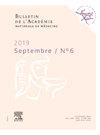健康空间
IF 0.2
4区 医学
Q3 MEDICINE, GENERAL & INTERNAL
引用次数: 0
摘要
太空探索不仅仅是征服新领域,它也是医疗创新的一个重要杠杆。以微重力、辐射和隔离为特征的太空环境给宇航员带来了生理、心理和生物方面的挑战。为了保护他们的健康,正在开发先进的技术解决方案,从远程医疗到生理监测系统,或更普遍的诊断和护理辅助系统。因此,空间任务带来的挑战可以加速创新,以满足空间需求和地球应用,特别是在获得保健机会有限的孤立或极端环境中的医疗监测。此外,来自空间的技术或数据,特别是通过观测、通信和地理定位卫星,可以在公共卫生方面发挥关键作用。它们有助于监测健康状况,发现影响人类健康的环境风险,并改善获得远程保健的机会,特别是在偏远地区。在法国,国家空间研究中心(CNES)和空间医学和生理研究所(MEDES)是这些进展的关键参与者。它们与科学和工业界合作,积极参与研究和开发适应空间探索挑战并可应用于地球需要的新医疗技术。通过这些努力,太空正在成为医学创新的实验室,宇航员和面临类似健康挑战的地球人口都能从中受益。太空探索不仅仅是征服新领域,它也是医疗领域创新的主要驱动力。空间环境的特点是微重力或部分重力、辐射、隔离和限制,给宇航员带来重大的生理、心理和生物挑战。为了保障他们的健康,正在开发先进的技术解决方案,从远程医疗到生理监测系统和辅助诊断和护理技术。因此,空间挑战和限制以及相关的研发是卫生创新的驱动因素和加速器,这些创新可能有利于空间和地球上的卫生,特别是在获得卫生保健有限的极端和偏远环境中。此外,来自空间的技术和数据,特别是通过观测、地理定位和通信卫星,在公共卫生方面发挥着至关重要的作用。它们可以促进早期健康预警和流行病学监测,发现影响人类健康的环境风险,并改善特别是在偏远地区获得保健服务的机会。在法国,国家空间研究中心(CNES)和空间医学和生理学研究所(MEDES)是这些进展的关键参与者。他们与科学界和工业界合作,积极促进为空间探索的挑战量身定制的新医疗技术的研究和开发,同时可转让给地面应用。由于这些努力,太空已成为医学创新的实验室,其好处不仅惠及宇航员,也惠及地球上面临类似健康挑战的人口。本文章由计算机程序翻译,如有差异,请以英文原文为准。
L’espace au service de la santé
L’exploration spatiale dépasse la simple conquête de nouveaux territoires, elle représente aussi un levier majeur d’innovation dans le domaine médical. L’environnement spatial, caractérisé par la microgravité, les radiations et l’isolement, impose des défis physiologiques, psychologiques et biologiques aux astronautes. Pour préserver leur santé, des solutions technologiques avancées sont développées, allant de la télémédecine aux systèmes de surveillance physiologique ou plus généralement à des systèmes d’assistance pour l’aide au diagnostic et aux soins. Les défis que posent les missions spatiales permettent ainsi d’accélérer des innovations pour répondre à la fois aux besoins spatiaux et à des applications sur Terre, notamment pour le suivi médical en environnements isolés ou extrêmes où l’accès aux soins est limité. Par ailleurs, les technologies ou données issues du spatial, notamment grâce aux satellites d’observation, de communication ou aux services de géolocalisation, peuvent jouer un rôle crucial en santé publique. Elles permettent de contribuer à la surveillance sanitaire, de détecter des risques environnementaux affectant la santé humaine et d’améliorer l’accès aux soins à distance, notamment dans les zones reculées. En France, le Centre national d’études spatiales (CNES) et l’Institut de médecine et de physiologie spatiales (MEDES) sont des acteurs clés dans ces avancées. En collaboration avec les communautés scientifiques et industrielles, ils participent activement à la recherche et au développement de nouvelles technologies médicales adaptées aux défis de l’exploration spatiale et transposables aux besoins terrestres. Grâce à ces efforts, l’espace devient un laboratoire d’innovation médicale, dont les retombées bénéficient aussi bien aux astronautes qu’aux populations terrestres confrontées à des défis similaires en matière de santé.
Space exploration goes beyond the mere conquest of new territories, it is also a major driver of innovation in the medical field. The space environment, characterized by microgravity or partial gravity, radiations, isolation and confinement, presents significant physiological, psychological and biological challenges for astronauts. To safeguard their health, advanced technological solutions are being developed, ranging from telemedicine to physiological monitoring systems and technologies for assistive diagnostic and care. Space challenges and constraints and the related R&D are thus a driver and an accelerator for health innovations that may benefit both for space and health on earth, especially for extreme and remote environments where access to healthcare is limited. Moreover, space-derived technologies and data, particularly thanks to observation, geolocalisation and communication satellites, play a crucial role in public health. They can contribute to early health warning and epidemiological surveillance, to the detection of environmental risks affecting human health, and the improvement of remote healthcare access, especially in isolated areas. In France, the National Centre for Space Studies (CNES) and the Institute for Space Medicine and Physiology (MEDES) are key players in these advancements. In collaboration with scientific and industrial communities, they actively contribute to research and the development of new medical technologies tailored to the challenges of space exploration while being transferable to terrestrial applications. Thanks to these efforts, space has become a laboratory for medical innovation, with benefits extending not only to astronauts but also to populations on Earth facing similar health challenges.
求助全文
通过发布文献求助,成功后即可免费获取论文全文。
去求助
来源期刊
CiteScore
0.50
自引率
33.30%
发文量
189
审稿时长
47 days
期刊介绍:
Rédigé par des spécialistes à l''intention d''une Communauté pluridisciplinaire le Bulletin de l''Académie nationale de médecine est au service de toutes les professions médicales : médecins, pharmaciens, biologistes et vétérinaires ainsi que de l''Administration et des institutions intervenant dans le domaine de la santé.
Les mémoires originaux et les mises au point sur des thèmes d''actualité sont associés au compte rendu des discussions qui ont suivi leur présentation. Les rapports des commissions sur l''éthique médicale l''exercice de la profession les questions hospitalières la politique du médicament et l''enseignement de la médecine justifient les recommandations de l''Académie.

 求助内容:
求助内容: 应助结果提醒方式:
应助结果提醒方式:


